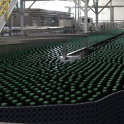|
Midorka posted:62 is pretty low for most ale strains that I've seen for the wort to be at. The strain that I'm using actually calls for a lower temperature than that to be ideal (Safbrew S-33 calls for 59* to 68*). I'm trying to get the most sugar fermented out as possible, so I went with a fairly high alcohol tolerant yeast that attenuates moderately (because I want a simple-base stout for my cherry puree and chocolate extract to play around in). I might just use good ole S-05 if this doesn't turn out right.
|
|
|
|

|
| # ? May 31, 2024 00:08 |
|
Fluo posted:My pots and such are generally 50 litres (13.2 US gallon/10.9 UK gallon) and mashtun 55litres / (14.5 US gallon/12.1 UK gallon), not really done a full 10UK gallon batch yet and was wondering before I have a go, the headroom for the boil wouldn't go past the 10.9 UK gallon mark if I kept poo poo together / under controll? Never had boil over before in smaller batches in smaller pots but generally is there anything to watch out for with bigger batches and is the set up right? (Normally do single infusion/continuous sparge). Fermcap-s is like unicorn tears or something, never even come close to a boilover since using it and my last boil was like 9 gallons in a 10 gallon pot.
|
|
|
|
Update: The exploding mead is very good. Also very sweet.
|
|
|
|
Feeling like a newbie right now. I brewed a barleywine on Saturday and pitched a 2L starter of WLP007 at 65 degrees. Now it's Wednesday and there still hasn't been any activity. No krausen, no bubbles, nothing. I know lag time is A Thing and RDWHAHB but is 4 days lag time normal for WLP007 in high gravity beers? At what point do I consider repitching?
|
|
|
|
internet celebrity posted:Feeling like a newbie right now. I brewed a barleywine on Saturday and pitched a 2L starter of WLP007 at 65 degrees. Now it's Wednesday and there still hasn't been any activity. No krausen, no bubbles, nothing. I know lag time is A Thing and RDWHAHB but is 4 days lag time normal for WLP007 in high gravity beers? At what point do I consider repitching? You could try aerating the wort more, even if that just consists of shaking the bucket/carboy as vigorously as you (safely) can. Or hit it with O2/filtered air if you have such things.
|
|
|
|
I had a long lag time (6-7 days before any real activity) on my Lambic mead and it was only 1.065. I think it'll be okay. The yeast are probably in there making yeast babies.
|
|
|
|
Docjowles posted:You could try aerating the wort more, even if that just consists of shaking the bucket/carboy as vigorously as you (safely) can. Or hit it with O2/filtered air if you have such things. I probably need to do this, I'm really bad about oxygenating since I normally use dry yeast. Underoxygenated wort makes yeast growth a bit sluggish, right? I'll hit it with a toothpick of olive oil when I get home and see what happens.
|
|
|
|
what's a toothpick of olive oil do? Sounds like witchcraft to me.
|
|
|
|
Marshmallow Blue posted:what's a toothpick of olive oil do? Sounds like witchcraft to me. New Belgium and some fermentation scientist Ph.Ds from UC-Davis I think put together a paper on using olive oil to provide advanced yeast nutrition in lieu of oxygenating wort. I think the goal was to eliminate any long-term oxidation. I think the conclusion was that it worked fine on a commercial scale, but the amount you would need to use on a homebrew scale would be infinitesimally small (less than the head of a toothpick.) So, yeah.
|
|
|
|
Marshmallow Blue posted:what's a toothpick of olive oil do? Sounds like witchcraft to me. IIRC, olive oil contains whatever molecule it is that yeast need oxygen to make, and if you provide that molecule directly then there is no need to aerate. Apparently the actual quantity of this molecule needed for a five-gallon batch is such that that you can add it by dipping the tip of a toothpick into some olive oil, then dipping the toothpick into your wort. Basically witchcraft.
|
|
|
|
added to wort or added to the yeast directly? One link I read said (added to the smack pack) was the olive oil and dried egg yolk for a starter, and it was very very highly viable
|
|
|
|
LeeMajors posted:New Belgium and some fermentation scientist Ph.Ds from UC-Davis I think put together a paper on using olive oil to provide advanced yeast nutrition in lieu of oxygenating wort. I think the goal was to eliminate any long-term oxidation. I think the conclusion was that it worked fine on a commercial scale, but the amount you would need to use on a homebrew scale would be infinitesimally small (less than the head of a toothpick.) So, yeah. One of the takeaways was, while it led to a full and healthy fermentation, it took something like 30% longer than traditional oxygenation. Which is why I think New Belgium rejected it. When you're talking about thousands and thousands of barrels sitting in the tank, time is money. I think we discussed this a few months back in the thread if you are bored enough to search for it. As an aside, the author of that paper is now a brewer at New Belgium 
|
|
|
|
Marshmallow Blue posted:what's a toothpick of olive oil do? Sounds like witchcraft to me. Witchcraft is about right but the general idea is yeast use oxygen for fatty acid production which the oil can provide in solution in spades. Even if it is more practical at commercial scales I think New Belgium thought it still tasted weird and it hasn't really taken off outside of homebrewers joking about sticking oily toothpicks everywhere.
|
|
|
|
So does it ACTUALLY make a difference in the end product for a homebrewer, aka is this something I should be trying? Doing a batch this Saturday. I don't care if it takes long if it actually makes it come out better.
|
|
|
|
Dead Inside Darwin posted:So does it ACTUALLY make a difference in the end product for a homebrewer, aka is this something I should be trying? Doing a batch this Saturday. I don't care if it takes long if it actually makes it come out better. My dad always told me, stick your oily toothpick everywhere. More seriously, its a really finnicky process at homebrew level where its really simple to aerate 5 gallons of wort even without toys like oxygen stones. Nothing wrong with trying anything though, especially if oily toothpicks are involved.
|
|
|
|
Docjowles posted:One of the takeaways was, while it led to a full and healthy fermentation, it took something like 30% longer than traditional oxygenation. Which is why I think New Belgium rejected it. When you're talking about thousands and thousands of barrels sitting in the tank, time is money. I think we discussed this a few months back in the thread if you are bored enough to search for it. I wonder if that would also apply to mead making and wine yeast. Because mead needs time anyways so an extra 30% Ferm Time compared to months and months of aging anyways is a non factor. But I think meads need more aeration than beers.
|
|
|
|
Here's the actual paper if you want to dive into the results. Edit: Also a probrewer.com thread where a guy actually put this into production. His experiences pretty much match up with the paper.
Docjowles fucked around with this message at 20:46 on Jun 5, 2013 |
|
|
|
Bad Munki posted:I'm not sure if you're kidding, but just in case: the "stilts" stick down into the bucket of water, stopping an inch or so above the bottom. I'm building a 3D printer and one of the first things I'm designing is going to be a small receptacle that hangs on the carboy neck with a hose barb on top that can take blow off. Each fermenter is self-contained so that it can be easily moved. I live somewhere where the ambient temperature inside can get up to 29C (84F) every day so I have to have a fermentation freezer and pulling fermenters out to take gravity readings makes it cumbersome to have an all-in-one or hose-in-a-common-jar setup in a way that I'm not resting the stopper on a potentially germ-filled place while I move the beer. That said, your blow off bucket with integrated airlock is pretty sweet. It would be nice if I could use something as quick and clever at that.
|
|
|
|
If I'm a spot lower than 5 gallons in my fermenter, can I just top up to 5 with some distilled water before siphoning to the bottle bucket?
|
|
|
|
You can, but I would not bother. -- Adding more water will require mixing to get it evenly distributed. That's going to add air at a time when the beer doesn't have a way to use it, increasing the risk of oxidation. -- A spot less beer just means the fermatnables were slightly more concentrated in the fermenter - which in turn means the ABV is a spot higher. Probably not enough to notice in any case, though.
|
|
|
CapnBry posted:I've switched to just putting 1/2" ID tubes into stoppers in all my fermenters and having them blow off into an empty pot. That's exactly what you're supposed to do (and what I've done) except you should put water in the empty pot so that air can only flow one way. Voila: typical blowoff setup. 
|
|
|
|
|
Is it just me, or does this Kickstarter seem really over the top? I mean, who's too busy to change the controller temperature maybe once per day? I am pretty interested in the BeerBug that continually monitors temperature and gravity. Has anyone tried it?
|
|
|
Thufir posted:Fermcap-s is like unicorn tears or something, never even come close to a boilover since using it and my last boil was like 9 gallons in a 10 gallon pot. Thanks mate, going to order some! 
|
|
|
|
|
nesbit37 posted:My kegerator died a while ago and I don't really want to replace it until I move out of this apartment and have more space to build a keezer. I figure a jockey box would be a decent temporary replacement since I could use one anyway. Does anyone know of anywhere with reasonably priced parts kits or at least a parts list and where I should buy them from? I think the only cheap way to do it is to build one yourself. The cheapest premade ones I've seen are at http://www.beveragefactory.com/draftbeer/jockey-boxes/jockey-boxes.shtml and you could buy a craigslist fridge/freezer for that price. All you need is a copper or stainless coil in a cooler going out to some barbs, you could use a compression fitting to connect the coil to a barb. Run tubing from the barbs to a quick disconnect and you're done.
|
|
|
|
ExtremistCow posted:Is it just me, or does this Kickstarter seem really over the top? I mean, who's too busy to change the controller temperature maybe once per day? I am pretty interested in the BeerBug that continually monitors temperature and gravity. Has anyone tried it? Honestly, that temp controller looks pretty loving sweet. That'd be great for those that have a busy schedule, also I like that it will gradient the temperature over a period of time. It's a shame I won't be able to afford it though. Speaking of temperature controllers and not speaking of refractometers, can anyone recommend a good cheap one of each? I know there was talk a few pages back, but I was dumb and didn't save the posts or bookmark the items.
|
|
|
|
The STC-1000 is your go-to for a cheapo temperature controller. Some assembly required, make sure you're getting the right AC voltage model. Liked mine enough I bought a second one for another project.
|
|
|
|
Jo3sh posted:You can, but I would not bother. What about when racking into the secondary? Or just don't bother whatsoever? I ended up aerating the primary by sloshing a little, and a little dribble eked out where the lid and rim interfaced. I smelled it and it's clearly got an active yeast smell and a hint of banana & stone fruit esters. So my fretting was unnecessary about the yeast being viable! As a bonus, I took all my depleted grains and made tabbouleh with them and a few things from my garden. 
|
|
|
|
Allahu Snackbar posted:What about when racking into the secondary? Or just don't bother whatsoever? For your average beer it's not worth it. It can help clarity but so can just leaving it an extra week in primary and then cold crashing if you have the capability. Cold crashing just means putting it somewhere cold (like fridge temps) for a couple days which forces a lot of yeast to drop out of suspension and sink to the bottom. Racking to secondary is another chance to introduce infection and oxidation for minimal gain. It's most helpful when you're adding something like fruit or coffee grounds that could get bound up in the trub at the bottom. Also, wanna eat dat tabbouleh 
|
|
|
|
That tabouli looks delicious
|
|
|
|
eviltastic posted:The STC-1000 is your go-to for a cheapo temperature controller. Some assembly required, make sure you're getting the right AC voltage model. Liked mine enough I bought a second one for another project. Yeah, I saw that, but someone linked something else a few pages ago...renco? Or something...It was $20-$30 and easy to install. No assembly of the object required. Edit: I decided to finally buy a refractometer. I bought this one. Anyone have any experience with it? It says it gets slightly inaccurate as the wort gets higher density, but it seems like it should be very accurate for FG and determining alcohol, just not OG. Midorka fucked around with this message at 08:27 on Jun 6, 2013 |
|
|
|
The problem with that is the alcohol refracts light differently from sugar water. I don't exactly know the science, but I believe as alcohol increase the accuracy of it goes down.
|
|
|
|
I am making my first all grain batch this weekend. I think it will be a Smash beer using Simcoe hops but I don't know what malt I want to use. I want to buy malt in bulk. What is the most versatile base malt? I know with extracts the most versatile extract is the lightest you can get; does the same apply to grain?
|
|
|
|
edit: ^ Versatile? American 2-row but I think it's a bit boring. I use Muntons Maris Otter in just about everything that doesn't call for Pilsner malt. Well, either the olive oil did the trick or WLP007 takes its time getting started because the barleywine was bubbling away this morning. internet celebrity fucked around with this message at 13:27 on Jun 6, 2013 |
|
|
|
Midorka posted:Yeah, I saw that, but someone linked something else a few pages ago...renco? Or something...It was $20-$30 and easy to install. No assembly of the object required. That's the one everybody has. If you're worried about scale inaccuracy brix is already an arbitrary scale and you can callibrate as you wish if you remember any highschool chemistry or statistics but there's probably not a real reason to. As mentioned FG needs a conversion based on some assumptions and the OG.
|
|
|
|
zedprime posted:That's the one everybody has. If you're worried about scale inaccuracy brix is already an arbitrary scale and you can callibrate as you wish if you remember any highschool chemistry or statistics but there's probably not a real reason to. I'm not too worried about FG/OG, I'm more worried about getting an accurate ABV calculation since I'm pretty sure my hydrometer is poo poo. I really don't trust it. Every batch of mine finishes under 1.010, even a pale ale I mashed at 153 and fermented with American Ale.
|
|
|
|
Midorka posted:I'm not too worried about FG/OG, I'm more worried about getting an accurate ABV calculation since I'm pretty sure my hydrometer is poo poo. I really don't trust it. Every batch of mine finishes under 1.010, even a pale ale I mashed at 153 and fermented with American Ale. I have had a similar experience. My calculated attenuation has never been below 85%, regardless of yeast or OG. Which hydrometer are you using? I'm using this one I think.
|
|
|
|
Have you tested the hydrometer? It should read 1.000 in distilled water at whatever temperature it's calibrated for (should say right on it, usually 60F).
|
|
|
|
Midorka posted:I'm not too worried about FG/OG, I'm more worried about getting an accurate ABV calculation since I'm pretty sure my hydrometer is poo poo. I really don't trust it. Every batch of mine finishes under 1.010, even a pale ale I mashed at 153 and fermented with American Ale. You need accurate OG and FG for an accurate abv. A hydrometer is more accurate as a more direct measurement. But that's splitting hairs. You can prove real fast if you dont believe the calibration slip that comes with them by making some sugar solutions of known content. Refractometers are fantastic for being piss simple and having small samples so I'm not coming down on them or anything.
|
|
|
|
Docjowles posted:Have you tested the hydrometer? It should read 1.000 in distilled water at whatever temperature it's calibrated for (should say right on it, usually 60F). I have, mine was pretty close (I think it is at 60F).
|
|
|
|

|
| # ? May 31, 2024 00:08 |
|
Midorka posted:I'm not too worried about FG/OG, I'm more worried about getting an accurate ABV calculation since I'm pretty sure my hydrometer is poo poo. I really don't trust it. Every batch of mine finishes under 1.010, even a pale ale I mashed at 153 and fermented with American Ale. You're gonna love how you calibrate your refractometer  c.f. http://seanterrill.com/2011/04/07/refractometer-fg-results/
|
|
|






























